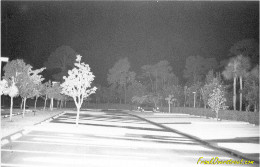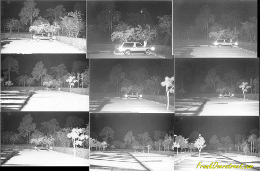Trail Camera
Sometime circa 1988/89 I had an idea for developing a motion/heat activated camera for use in night time and low/no light photography. I believed such capability could be used by sportsmen, wildlife officers, biologists, security personnel and others.
Fixed focus 35mm auto wind cameras that printed a timestamp on the print could be purchased for about $40. I wanted to find a way to use such camera mounted inside a discrete housing to capture heat/motion triggered images.

My SUV at 100 meters in an unlit parking lot using Kodak T-Max 3200 film at 1/250, stock 50mm lens, maximum aperture and an IR filter over the flash.
Click image to enlarge.
I learned that Kodak manufactured a black and white film called T-Max 3200 that was extremely light sensitive and might be capable of doing the job. The nominal ASA rating was 3200 but it could be pushed much higher.
I was experienced at pushed speed photography and knew how to interpolate settings from one speed film to that of the “pushed” speed. I first wanted to find out what the film was capable of out of the box. I interpolated settings for ASA 3200 and went out on a dark night to try it out.
Without a flash or special lens, the best I could get to was a 1/15 shutter speed. I recognized such a speed would result in blur but this was just the first test. I dropped the roll off at a specialty camera store for processing and a week later was very pleased to see the results. There was blur but the exposures were very good. Much better than I expected with a deep field of view.
I set out again one night with a flash but when the prints came back, they were completely washed out except for the highest shutter speed. So, I decided to attenuate the flash with an IR filter. I purchased assorted IR filter material which I had experience with from my days of IR photography. I placed the IR filter over the flash lens and went out on another comparatively dark night. I estimated I should be able to shoot as high as 1/250 of a second. I used the darkest area of my office park and parked my SUV at the edge of an empty unlighted lot bordering a golf course. Not knowing what to expect, I placed a white t-shirt over the antenna to help brighten things up. I then stepped back in increments of about 15 meters and took two photo's, one at 1/125 and another at 1/250. A week later when I opened the envelope of prints, the results exceeded my wildest expectation.

Montage of prints taken at night from various distances in a dark parking lot with different IR filters.
Click image to enlarge.
At 100 meters, my SUV was clearly illuminated. I didn't recognize it but at that moment, I had everything needed to put together a reliably working motion/heat activated trail camera at a time when no such product existed. Unfortunately, rather than putting something together that would work, filing what patents could be filed, obtaining funding and proceding to develop an improved version, I became fixated on perfecting the device by developing a photochromic filter that would function 24/7 in all light conditions rather than using a photocell and IR filter to limit operation to suitable light conditions.
I spent weeks in the library at FAU researching photochromics until I got distracted with something and abandoned the effort never realizing I already had the ingredients of a product that would sell.




